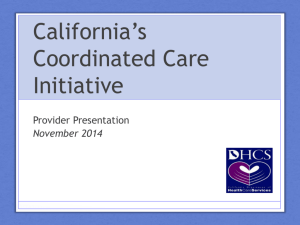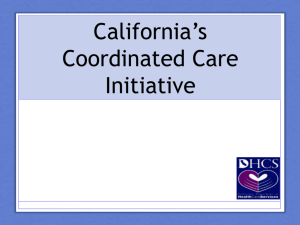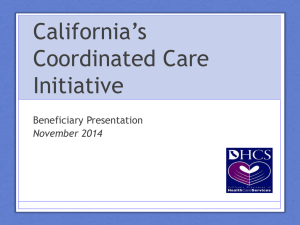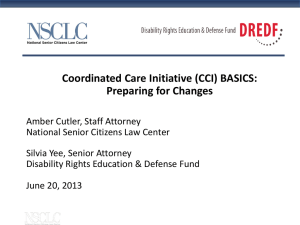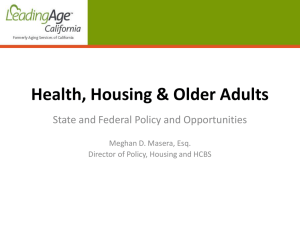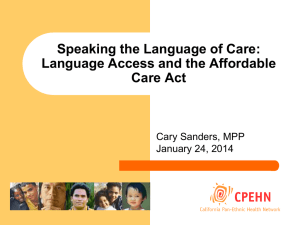California*s Coordinated Care Initiative
advertisement
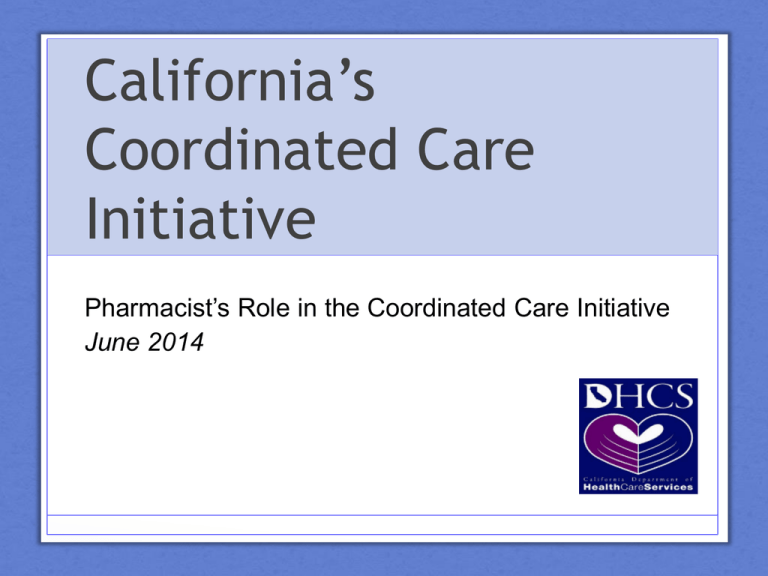
California’s Coordinated Care Initiative Pharmacist’s Role in the Coordinated Care Initiative June 2014 Today’s Webinar • This webinar is designed specifically for pharmacists. • The presentation covers the Coordinated Care Initiative (CCI), choices under the CCI, and the information that pharmacists need to know. • For more information about the CCI, please visit CalDuals.org and review the provider section. 2 Learning Objectives • California’s Coordinated Care Initiative • Enrollment choices • Beneficiary noticing • Important information for pharmacists • Resources for beneficiaries 3 The Coordinated Care Initiative • March 2013 - California reached an agreement with Centers for Medicare and Medicaid Services (CMS) to participate in a State Demonstration to Integrate Care for Dual Eligible Individuals, which became known as the Coordinated Care Initiative (CCI). • The goal was to design person-centered models of care that coordinate primary, acute, behavioral and long-term supports and services for people who receive both Medicare and Medi-Cal, also known as dual eligibles or Medi-Medis. • CA chose a capitated model, where plans receive a prospective, blended payment to provide Medicare and Medi-Cal enrollees with coordinated care and all of their Medicare and Medi-Cal benefits. 4 CCI Counties San Mateo Alameda Santa Clara San Bernardino Los Angeles Riverside Orange* San Diego *Participation in Orange County pending readiness reviews. 5 Medicare and Medi-Cal Today Medicare Medi-Cal • • Doctors Long-term services and supports • MSSP: Multipurpose Senior Services Program • IHSS: In-Home Supportive Services • CBAS: Community-Based Adult Services • Nursing facilities • Hospitals • Prescription drugs 6 • Durable medical equipment • Medicare cost sharing Problems with the Current Delivery System • Programs in silos • Who pays for what? • Where do I go for help? • Fundamentally: a lack of coordinated care • A lack of support for both providers and consumers 7 Why Coordinated Care - 1 • With separate administration, Medicare and Medi-Cal create unhelpful incentives to shift costs to the other program rather than manage the care and costs of providing all the benefits and services that enrollees are eligible for under both programs. • People with both Medicare and Medi-Cal tend to be a high needs, high cost population. The 26% of Medicare recipients in California who are duals account for 36% of Medicare costs; and the 11% of Medi-Cal recipients in California account for 35% of the costs. 8 Why Coordinated Care - 2 • Some people with multiple chronic conditions see many different doctors and have multiple prescriptions. • This is common among people with both Medicare and Medi-Cal who often have higher health needs and less financial means than other beneficiaries. • Today’s care delivery system doesn’t always support the care coordination many people need. This leads to increased risk of admission to the hospital or a nursing home. 9 Why Coordinated Care - 3 To bring Medicare and Medi-Cal services together in one health plan and to support beneficiaries with care coordination to ensure: • The Right Care • At the Right Time • In the Right Place 10 Enrollment Choices With the number of choices offered to dual eligible beneficiaries, we expect many will turn to trusted health care advisors for advice and counsel, which in many cases will be their pharmacist. • Cal MediConnect • Medi-Cal – Managed Long-Term Services and Supports • PACE – Program of All-Inclusive Care for the Elderly 11 Cal MediConnect Who: People with both Medicare (parts A and B & D) and full Medi-Cal Optional: Beneficiaries can opt out, or do nothing and be enrolled in a pre-selected plan. • All of the Original Medicare (parts A, B. & D) and Medi-Cal services that beneficiaries currently receive are combined into one health plan • One number to call for all needs • Additional vision and transportation benefits • Access to Interdisciplinary Care Team • Access to care manager • Coordinated care 12 Medi-Cal Managed Long-Term Services and Supports Who: Medi-Cal only beneficiaries or dual eligibles who chose not to join Cal MediConnect Mandatory: Beneficiaries not already receiving their Medi-Cal through a managed care plan will be required to select one for their benefits. • Beneficiaries keep the MediCal services they currently have • Medi-Cal long-term services and supports (MLTSS) and Medi-Cal services are provided through managed care plans • Beneficiaries keep their Medicare Fee-For-Service or with their Medicare Advantage plan 13 PACE Program of All-inclusive Care for the Elderly Who: Beneficiaries with both Medicare and Medi-Cal or with MediCal only Beneficiaries may be eligible to enroll in a PACE program If they: • Are 55 or older • Live in your home or community setting safely Option for some beneficiaries if they’re eligible • Need a high level of care for a disability or chronic condition • Live in a ZIP code served by a PACE health plan 14 Cal MediConnect Plan Options Los Angeles Alameda • Care1st, CareMore, Health Net, LA Care and Molina Health • Alameda Alliance and Anthem Blue Cross Orange* Santa Clara • CalOptima • Anthem Blue Cross and Santa Clara Family Health Plan San Diego San Bernardino • Care 1st, Community Health Group, Health Net and Molina Health • Inland Empire Health Plan and Molina Health Riverside San Mateo • Inland Empire Health Plan and Molina Health • Health Plan of San Mateo *Participation in Orange County pending readiness reviews. 15 Assessment Questions • How many choices do beneficiaries have? • What are those choices? 16 Beneficiary Noticing • Most eligible beneficiaries will receive notices 90, 60, and 30 days prior to their coverage date. • For most people their coverage date is the first day of their birth month. • Cal MediConnect and MLTSS information from the state will arrive in blue envelopes. 17 Tell People to Look for the Blue Envelopes 18 Cal MediConnect Notices 90 Day Notice 60 Day Notice 19 30 Day Notice Cal MediConnect Guidebook 20 Part D 60-Day Insert This is the notice that is being sent to eligible beneficiaries to explain why they’re receiving Part D disenrollment notices. 21 MLTSS Notices 90 Day Notice 60 Day Notice 22 30 Day Notice Choice Form Section 3: Cal MediConnect Plan To select a Cal MediConnect plan, beneficiaries will complete section 3 ONLY. Section 5: Medi-Cal Plan To “Opt-Out” of Cal MediConnect, beneficiaries should fill out section 5 ONLY. They should choose the Medi-Cal plan they are already in or select the Medi-Cal plan they want to join. 23 Assessment Questions • How many notices are beneficiaries receiving for Cal MediConnect? • When do beneficiaries receive their guide book? • What are the two options beneficiaries have to exercise their choices? 24 Important Information for Pharmacists - 1 • When beneficiaries join Cal MediConnect plans, they are disenrolled from their Part D plan and covered by their Cal MediConnect plan for prescription drugs. • Beneficiaries will receive notice that they have been disenrolled from their Part D plan about the same time they receive their 60 day Cal MediConnect notice. These notices will likely drive people to ask their pharmacist for advice. • Beneficiaries should not experience any gap in Part D coverage because the effective date of the disenrollment from their current Part D plan is the first day of Cal MediConnect coverage. 25 Part D Disenrollment Notice This is a sample of the notice that is being sent to eligible beneficiaries to explain the transition between their Part D plan and their new Cal MediConnect plan 26 Important Information for Pharmacists - 2 • People will have Cal MediConnect cards from their Cal MediConnect plan. • When someone doesn’t have their card, your computer system will indicate which Cal MediConnect plan the beneficiary has chosen. • If you have questions about a someone’s eligibility for Part D coverage, call the Medicare Low Income NET (LI-NET) contractor at 1-800-783-1307. • LI-NET also ensures that beneficiaries are still able to obtain immediate prescription drug coverage during transitions. 27 Important Information for Pharmacists - 3 • If someone chooses not to join Cal MediConnect before their coverage date, they will retain their prior Part D plan, but it could take some time for the systems to show this. • Beneficiaries may have an opt out confirmation notice, or 1-800-MEDICARE can help determine the person’s Part D plan. • If a person is enrolled in a Cal MediConnect Plan and later decides to disenroll, they can enroll in a Medicare or PDP plan right away and do not need to wait for the next open enrollment period. 28 Important Information for Pharmacists - 4 • If a person needs a drug not covered by their new plan, all Part D transition rules apply to Cal MediConnect plans. • Cal MediConnect plans are required to cover one 30-day refill of currently prescribed, Medicare approved prescriptions, even if it is not in the plan’s formulary. This will help ensure that consumers should not experience any gap in their prescription drug coverage. • If there is a question about coverage of a prescription drug, contact the Cal MediConnect plan. 29 Consumer Protections The law establishing the CCI contains many protections, including: • Meaningful information of Beneficiary Rights and Choices • Notices sent 90, 60, and 30 days prior to enrollment. • Self-Directed Care • People will have the choice to self-direct their care, including being able to hire, fire, and manage their IHSS workers. • Appeal & Grievances • People will receive full Medicare and Medi-Cal appeals and grievances. There will be a special Ombudsman program for Cal MediConnect. • Strong Oversight & Monitoring • Evaluation coordinated with DHCS and CMS. • Continuity of Care • People can continue to see their Medi-Cal providers for 12 months and their Medicare providers for six months. 30 How can you advise your patients? • Beneficiaries you work with will receive notices 90, 60, and 30 days prior to their eligibility date. You may want to advise them to be on the lookout for these letters and blue envelopes. • Additional resources: • For Counseling - The Health Insurance Counseling and Advocacy Program (HICAP): 1-800-434-0222 • For Enrollment - Health Care Options: (844) 580-7272 or TTY: (800) 430-7077 • Medicare.gov > Plan Finder or 1-800-Medicare 31 Resources to help Beneficiaries • Each Cal MediConnect Plan has a pharmacy network, which is set forth in their provider directory. Provider directories are on each plan’s website and on www.calduals.org, which also contains a wealth of information about the Cal MediConnect and the CCI. • On calduals, go to your county on the “CCI Counties” menu, and you will find links to the plan provider directories. • The Cal MediConnect Plans formularies are all compliant with the Medicare Part D requirements and are available on the Medicare,gov plan comparison tool: http://www.medicare.gov/find-a-plan/questions/enter-yourinformation.aspx 32 Consumer Protections: Who To Call for Beneficiaries • If a beneficiary has a complaint, the first point of contact is be the plan. Plans will have internal appeals and grievance procedures. • If a beneficiary cannot resolve their complaint with the plan, there are several options: Cal MediConnect Ombudsman Program (855) 501-3077 Medi-Cal Managed Care Ombudsman (888) 452-8609 Office of the Patient Advocate (866) 466-8900 33 Questions or Comments • Visit CalDuals.org • Email info@calduals.org 34
